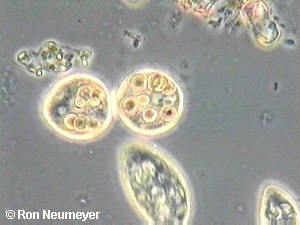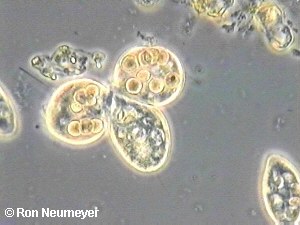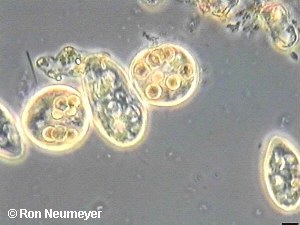A
protozoan undergoes "binary fission" - with some help!
by
Ron Neumeyer
These images, captured
from video using a Snappy video grabber, illustrate the final
stages of protozoan asexual reproduction (a process known as
"binary fission"). The organism undergoing division, a
small ciliate, gets a helping hand from one of its
"cohorts" during the final stage, separation of the two
daughter cells.

|
A second protozoan
(lower centre) approaches the protozoan (centre)
undergoing binary fission
|
The second
protozoan forces it's way between the two daughter cells
|

|

|
Aiding the binary
fission process in a rather unorthodox way!
|
Binary fission generally produces
daughter cells with genetic material (DNA) identical to that of
the parent. It is an efficient way for protozoa to increase in
number during periods when environmental conditions are
relatively stable. However, when environmental conditions begin
to change, sexual reproduction generally becomes more prevalent.
Sexual reproduction allows for the mixing of DNA among the
various strains (asexual daughters) of a local protozoan
population. Shuffling the deck in this manner produces cells
which are genetically different from each other, an important
characteristic as genetic make-up determines how cells respond to
their environment. A genetically diverse population has more
"options" in the face of changing conditions. In the
biological world survival of the species is the ultimate
objective. The more diverse a species gene pool, the greater the
likelihood that it will persist.
Comments to the author Ron Neumeyer welcomed.
© Microscopy UK or their
contributors.
Please report any Web problems
or offer general comments to the Micscape Editor,
via the contact on current Micscape Index.
Micscape is the on-line monthly
magazine of the Microscopy UK web
site at Microscopy-UK
WIDTH=1
© Onview.net Ltd, Microscopy-UK, and all contributors 1995 onwards. All rights
reserved. Main site is at www.microscopy-uk.org.uk with full mirror at www.microscopy-uk.net.


